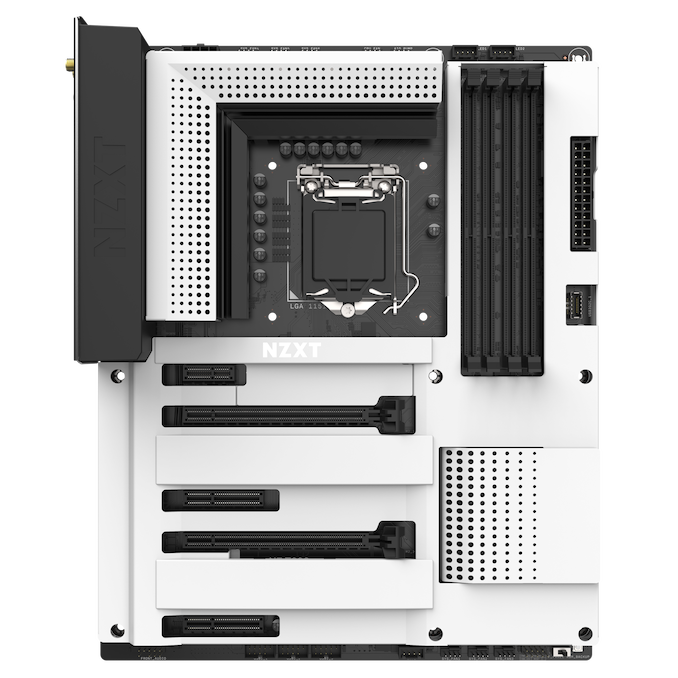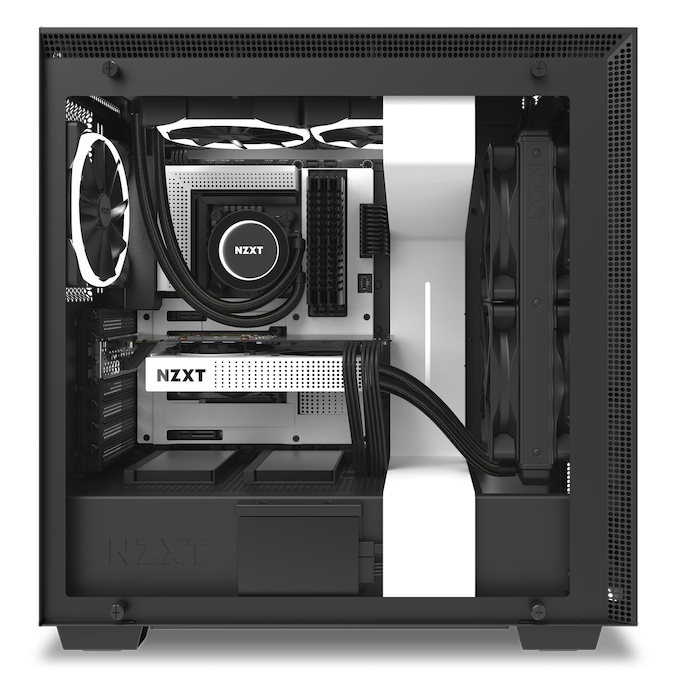Intel Z390 Motherboard Overview: 50+ Motherboards Analyzed
by Ian Cutress & Gavin Bonshor on October 8, 2018 10:53 AM EST- Posted in
- Motherboards
- Intel
- MSI
- Gigabyte
- ASRock
- EVGA
- Asus
- NZXT
- Supermicro
- Z390
NZXT N7 Z390
Right at the start of this year, NZXT launched their first 'component' onto the market and while NZXT themselves don't manufacturer computer hardware per say, the N7 Z370 which we reviewed at its launch. The N7 Z370 was manufactured by ECS o NZXT themselves created the majority its feature set with very unique aesthetics. The main selling point for NZXT on the N7 was through this unique design which included a full PCB cover with users having a choice between two primary color schemes; black cover and black PCB, or white cover and black PCB. NZXT essentially took the style from some of their renowned PC cases and integrated to the motherboard market giving users the ability to create something unique This full cover feature was enhanced with the inclusion of removable plates on the full cover which could be modified with spray paint, or with the option to purchase additional plates in different colors for an additional cost. Even the full cover could be removed, spray painted and re-designed to give the ultimate look, which is a rather refreshing idea given the number of users voiding their warranties with minor modifications to create their own style inside their systems.
The new NZXT N7 Z390 keeps much of the same specifications as the previous NZXT N7 Z370 board with a cover which stretches from top to bottom across the majority of the PCB with the only bare elements being located around the CPU socket and along the very top and bottom of the board. As with the N7 Z370, the N7 Z390 will be available with white or black full-PCB covers. The N7 Z390 also keeps the same PCIe layout with a full-length PCIe 3.0 x16 slot, a full-length PCIe 3.0 x8 slot, two PCIe 3.0 x4 slots and a single PCIe 3.0 x1 slot.
A total of two PCIe 3.0 x4 and SATA compatible M.2 slots are located under the cover with a supplement of just four SATA ports; an ATX sized board on a chipset offering six ports should really have six ports. The included SATA ports feature support for RAID 0, 1, 5 and 10 arrays. In regards to the cooling, the NZXT N7 Z390 is one of the more comprehensive offerings with a total of eight 4-pin fan headers with two designated as for a CPU fan and AIO pump, and the other six featuring support for 0 db mode with support for up to 6 W of power per channel.
On the rear IO is a good variation of connections including four USB 3.1 Gen2 Type-A ports, two USB 3.0 Type-A ports, a single LAN port controlled by an Intel I219V Gigabit NIC, with a total of five 3.5 mm audio jacks and S/PDIF optical output powered by a Realtek ALC1220 HD audio codec. A single HDMI 1.4b video output is present with a set of very handily placed buttons which consist of a clear CMOS, reset and power switch. The rear IO now includes an LED debug which is handy, but the location might not be when troubleshooting in a cramped location. Lastly there's two antenna connectors for the integrated 2T2R Wave 2 802.11ac capable Intel 9560 Wi-Fi adapter which offers users with compatible wireless networking capabilities to utilize up to 1.73 Gbps speeds.
The NZXT N7 Z390 has an MSRP of $280 which like it's predesessor (the N7 Z370) is directly placed into the higher end of Z390 offerings, with NZXT looking to compete with other premium offerings available on the chipset. The NZXT N7 Z390 is compatible with a wide variety of NZXT's other products with capability expanded on by the CAM software with HUE 2 and GRID+ support which offers control over RGB lighting and onboard fans respectively. Availability of the N7 Z390 is expected from the middle of November in the US market and in the EU towards the end of November.












79 Comments
View All Comments
gavbon - Tuesday, October 9, 2018 - link
Thank you Hickory, will update now; this information wasn't available to us at the timebill44 - Tuesday, October 9, 2018 - link
All this boards, but only 1 with Thunderbolt 3. Looks like Thunderbolt 3 is dead (free or not).Type C ports and HDMI 2.0 is in short supply too.
Hopefully next year, we can have two or more USB C (maybe even 3.2), HDMI 2.1, PCIe 4/5 and Thunderbolt 3/4 (Titan Ridge?). Or maybe not, just the same old things hoping for 2020/21.
DanNeely - Tuesday, October 9, 2018 - link
There's no licensing fee for TB, the controller chip itself still costs money (IIRC $20 or $30) and still eats 4 PCIe lanes. Worse, IIRC to make the video out feature work they need to be CPU lanes; meaning that adding it means your main GPU slot is an x8, and the secondary one only x4.gavbon - Tuesday, October 9, 2018 - link
Yeah it's a case of certain vendors opting to dismiss including TB3 ports, which only seems sensible on mini-ITX boards where PCIe lanes aren't too much of an issue. Consumer choice is important though and I'm still glad ASRock has included it; it could be a key buying decision for some!gamingkingx - Friday, October 12, 2018 - link
Just too bad it is only wired as a x2.. And it is wired into the chipset as far as I am aware, so you are gonna max out your I/Os pretty fast.bill44 - Wednesday, October 10, 2018 - link
Sure, anything you add will cost something. The are plenty of non-gamers who prefer TB3 vs x16.This also highlights how old current PC architecture is. Either we need more PCIe lanes, or faster lanes. Otherwise, all advances will be hindered.
Up to 6 USB 3.1 Gen 2 ports? You’ be lucky to get 4. Why can’t we have 6 Gen2 ports and the rest Gen1 an no antiquated USB 2.0? PCIe resources.
All new peripherals use Type C, but this boards generally give you only 1 (saving money on redrivers). USB 3.2 (20 Gbps)? When it comes around, ithis too will need more PCIe lanes. M.2. PCIe 3.0 x4? All lanes are maxed out; the only way forward is faster lanes.
In the past, Gigabyte was a TB3 champion including the functionality on many of their boards. Now, not a single one.
Cost saving by motherboard makers? Prioritising gamers? Or simply no demand for TB3.
The outcome is the same.
repoman27 - Thursday, October 18, 2018 - link
Intel merely said that they planned "to make the Thunderbolt protocol specification available to the industry under a nonexclusive, royalty-free license" sometime this year. This hasn't happened yet, and is referring to the protocol spec, not the silicon that Intel produces. If and when they decide to do this, ASMedia or whoever could then begin development of their own Thunderbolt controllers. This means that third-party controllers probably won't appear in shipping products until sometime in 2023.As for the currently available Thunderbolt 3 controllers, tray prices range from $6.45 to $9.10. But you also need a USB Type-C and PD controller, power switch, and high-speed mux which runs around $4.59, plus the connector and a few other bits. I don't believe Intel charges a royalty on finished Thunderbolt products, but they do require licensing and certification which are paid for by the OEM and may add significant cost to relatively low-volume products.
AFAIK, Windows PCs are still required to connect Thunderbolt controllers via the PCH. Apple is the only one using PEG lanes for Thunderbolt, and they don't do that on the 27-inch iMacs where it might adversely impact the GPU.
Dug - Tuesday, October 9, 2018 - link
I hope it's not dead. Far more useful than USB C. I would be fine with USB C except there doesn't seem to be a good USB C to USB C hub, which really restricts how many devices you can use. I'm really glad to see it on ASRock itx board so I can attach a portable SSD array.imaheadcase - Wednesday, October 10, 2018 - link
Tons of monitors of USB-C, anker sells USB-C hubs, I don't think i've seen thunderbolt in a desktop PC to date though. That best part of USB-C is being able to just plug phone into it and copy paste to desktop files (no Microsoft didn't invent that, it was always that way by default in windows)Valantar - Wednesday, October 10, 2018 - link
TB3 is far from dead, it just has little use in desktop PCs. Have you looked at laptop lineups recently? TB3 is _everywhere_. My workplace (a major university here in Norway) has moved entirely to TB3 docking solutions as they're the only full-featured and universal(-ish) solution.eGPUs are useless on desktops. Desktops don't need docks. USB 3.1 is plenty fast for external storage, and if you need faster storage, desktops can fit that internally. The only real use cases for TB3 on a desktop are TB3 networking (for fast direct transfers between PCs) and adding things like extra NVMe or >GbE networking on ITX boards that don't have room for that and a GPU.